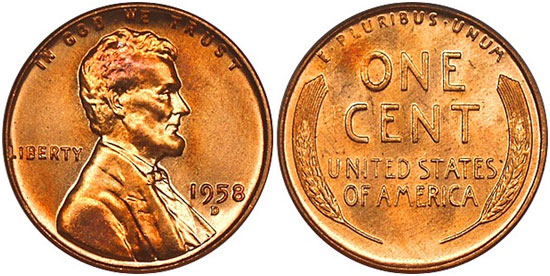The Lincoln Cent was introduced in 1909 and minted each year until 1958 with the “Wheat Ears” reverse design. This represented the first U.S. coin issued for general circulation to depict the likeness of an actual person, as all previous series had depicted various renderings of Liberty. Lincoln Wheat Cents are one of the most widely collected U.S. coin series. Many collectors got their start assembling sets from circulation and later moved on to other series or higher grade coins.

1958 Lincoln Wheat Cent
Victor David Brenner was the designer of the original Lincoln Cent. He was a Lithuanian-born immigrant who rose to prominence as a sculptor, engraver, and medalists within America. His work had come to the attention of President Theodore Roosevelt, who had sat for Brenner for a Panama Canal commemorative medal. President Roosevelt saw a bronze plaque featuring a bust of Lincoln, which had been prepared by Brenner earlier, and favored this image as the new design for the cent. As adapted for the obverse of the cent, a profile portrait of Lincoln appears facing right, with the inscription IN GOD WE TRUST above, LIBERTY in the left field, and the date in the right field.
Brenner’s original reverse design features a pair of wheat stalks, broadly enclosing the inscriptions ONE CENT and UNITED STATES OF AMERICA. The motto E PLURIBUS UNUM appears above. The original galvanos included the sculptor’s last name “BRENNER” in small block letters on the reverse. Treasury officials requested it to be removed, and the initials “V.D.B.” were placed in the same position instead.
When the new cents were released during the first week of August, the designer’s initials caused a great deal of controversy. Press coverage was intense and the public soon concluded that the initials were too prominent. The Mint acted quickly to remove the initials, creating the famous key date 1909-S V.D.B. Lincoln Cent. Ultimately, the initials would reappear in 1918, although much smaller and barely visible on the truncation of Lincoln’s shoulder. The initials have continued to be featured in the same position ever since.
The Wheat Cent was produced at all three Mints in use at the time, Philadelphia, Denver, and San Francisco. Production was generally the highest at the Philadelphia Mint, and smaller at the branch Mints. As a result, most of the scarcer issues of the series were produced at one of the two branch-Mints.

